
In Greek mythology, Narcissus was a hunter from Thespiae in Boeotia who was known for his beauty which was noticed by all, regardless of gender. According to the best known version of the story, by Ovid, Narcissus rejected all advances, eventually falling in love with a reflection in a pool of water, tragically not realizing its similarity, entranced by it. In some versions he beat his breast purple in agony at being kept apart from this reflected love, and in his place sprouted a flower bearing his name.

In Greek mythology, Echo was an Oread who resided on Mount Cithaeron. Zeus loved consorting with beautiful nymphs and often visited them on Earth. Eventually, Zeus's wife, Hera, became suspicious, and came from Mount Olympus in an attempt to catch Zeus with the nymphs. Echo, by trying to protect Zeus, endured Hera's wrath, and Hera made her only able to speak the last words spoken to her. So when Echo met Narcissus and fell in love with him, she was unable to tell him how she felt and was forced to watch him as he fell in love with himself.

Black Narcissus is a 1947 British psychological drama film written, produced, and directed by Michael Powell and Emeric Pressburger, and starring Deborah Kerr, Sabu, David Farrar, and Flora Robson, and featuring Esmond Knight, Jean Simmons, and Kathleen Byron. The title refers to the Caron perfume Narcisse Noir.

Narcissus is a genus of predominantly spring flowering perennial plants of the amaryllis family, Amaryllidaceae. Various common names including daffodil, narcissus and jonquil, are used to describe all or some members of the genus. Narcissus has conspicuous flowers with six petal-like tepals surmounted by a cup- or trumpet-shaped corona. The flowers are generally white and yellow, with either uniform or contrasting coloured tepals and corona.
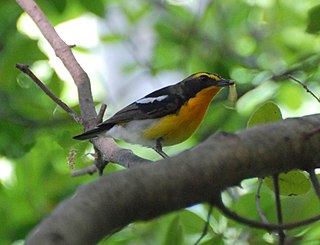
The narcissus flycatcher is a passerine bird in the Old World flycatcher family. It is native to the East Palearctic, from Sakhalin to the north, through Japan across through Korea, mainland China, and Taiwan, wintering in southeast Asia, including the Philippines, Vietnam and Borneo. It is highly migratory, and has been found as a vagrant from Australia in the south to Alaska in the north.
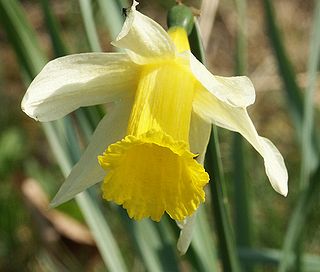
Narcissus pseudonarcissus, commonly named the wild daffodil or Lent lily, is a perennial flowering plant.
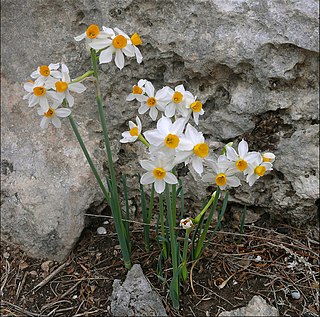
Narcissus tazetta is a perennial ornamental plant that grows from a bulb. Cultivars of N. tazetta include 'Paperwhite', 'Grand Soleil d'Or' and 'Ziva', which are popularly used for forcing indoors, as is the form of N. tazetta known as Chinese Sacred Lily.

Saint Narcissus of Jerusalem was an early patriarch of Jerusalem. He is venerated as a saint by both the Western and Eastern Churches. In the Roman Catholic Church, his feast day is celebrated on October 29, while in the Eastern Orthodox Church it is celebrated on August 7.

Hypochrysops is a genus of butterflies in the family Lycaenidae first described by Cajetan Felder and Rudolf Felder in 1860. This particular genus is exclusive to the Australian area with only a few species straying into Papua New Guinea.
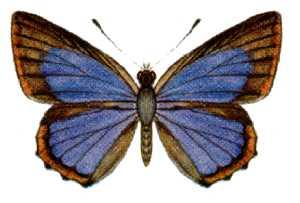
Hypochrysops halyaetus, the western jewell, is a member of the family Lycaenidae of butterflies. It lives in Australia.

Hypochrysops epicurus, the dull jewel, is a butterfly of the family Lycaenidae found in Australia.
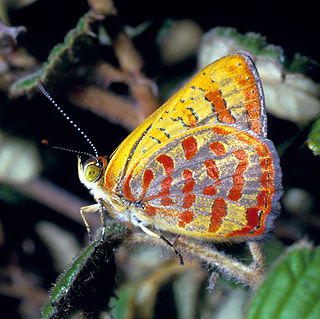
Hypochrysops byzos, the yellow-spot jewel, is a member of the family Lycaenidae. Its range consist of eastern Australia. The wingspan of both the male and female is about 3 cm.

Myrmecodia beccarii, ant-house plant, is an epiphytic plant on Melaleuca trees and others with spongy bark in the wetlands and mangroves of tropical north Queensland, Australia from Cooktown to Mission Beach. The prickly, swollen stems develop natural hollows which are invaded by the golden ant in a symbiotic arrangement. The ants patrol the plant, removing leaf-eaters, while their excreta is absorbed by the plant for nutrition.

Dendrophthoe vitellina, commonly known as long-flowered- or apostle mistletoe, is a hemiparasitic plant of the mistletoe family Loranthaceae. The genus Dendrophthoe comprises about 31 species spread across tropical Africa, Asia, and Australia. Despite being collected by Joseph Banks and Daniel Solander in 1788, and depicted in Banks' Florilegium, it was not until 1860 that it was described by Ferdinand von Mueller as Loranthus vitellinus after being collected near Ipswich, and renamed by Philippe Édouard Léon Van Tieghem in 1895.

Hypochrysops dinawa is a species of butterfly of the family Lycaenidae. It is found from southern New Guinea to Papua New Guinea.

Hypochrysops delicia, the moonlight jewel, is a member of the family Lycaenidae. It is found in eastern Australia.















